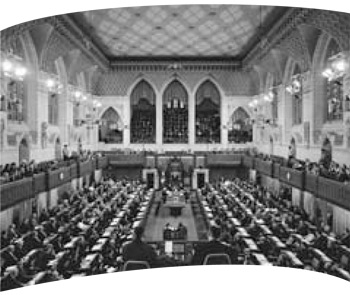Canada's House of Commons
the Report
March 31, 2007
This report summarizes activities in the period
corresponding to the standard government
fiscal year.
Parliamentary Sessions
Covered in
this Period
1st session,
39th Parliament
(April 3, 2006 - )
Key Date
April 3, 2006 -
First session of the
39th Parliament begins
Total number of sitting days
2006-2007 130 days
Confederation Hall, shown on the cover of this report, probably best symbolizes the House of Commons. Arranged around a central column, the Hall represents the coming together of the provinces and territories to form a country. The many carvings that adorn this circular arcaded entrance foyer illustrate such Canadian values as peace, integrity and justice.
Like Confederation Hall, the House of Commons is a meeting place. Representatives from every corner of the country come together in the Chamber and committee rooms. They bring their constituents' ideas and concerns to share with their fellow Members of Parliament. They make decisions that can affect every aspect of our lives. The House of Commons also reaches out to Canadians with information and proposals, welcoming their feedback. These avenues of communication can take many forms, from face-to-face meetings to webcasts. Communication is essential to the House of Commons as a venue in which all ideas may be expressed.
The Report to Canadians 2007 presents the work of Members and the House Administration from April 1, 2006 to March 31, 2007, and the Administration's goals for the upcoming fiscal year. It also offers information on membership in the House of Commons and on the activities of Members of Parliament.
The Role of a Member of Parliament
While most people think of Members of Parliament as legislators, they have many other duties as well; these include assisting constituents and representing Canada internationally. Their activities can be divided into four main areas:
Chamber activities-In the Commons Chamber, Members debate and vote on proposals, present documents and petitions, ask questions of the government, and raise issues of importance to Canadians.
Committee work-Members serve on committees, where they examine bills, departmental expenditures and current issues in depth.
Helping constituents-Constituents contact their Members of Parliament when they need help in connection with federal government programs and services, and when they want to discuss matters of concern.
Representing Canada-Members have a role to play internationally by representing Canada''s interests, promoting democratic institutions and strengthening ties with other countries.

Members in the House of Commons, 39th Parliament.
Photo: © Library of Parliament/Roy Grogan
| Province | Cons. | Lib. | BQ | NDP | Ind. | Vacant | Total |
|---|---|---|---|---|---|---|---|
| Alberta | 28 | 28 | |||||
| British Columbia | 18 | 8 | 10 | 36 | |||
| Prince Edward Island | 4 | 4 | |||||
| Manitoba | 8 | 3 | 3 | 14 | |||
| New Brunswick | 3 | 6 | 1 | 10 | |||
| Nova Scotia | 3 | 6 | 2 | 11 | |||
| Ontario | 40 | 53 | 12 | 1 | 106 | ||
| Quebec | 10 | 12 | 50 | 1 | 2 | 75 | |
| Saskatchewan | 12 | 2 | 14 | ||||
| Newfoundland and Labrador | 3 | 4 | 7 | ||||
| Nunavut | 1 | 1 | |||||
| Northwest Territories | 1 | 1 | |||||
| Yukon | 1 | 1 | |||||
| National Total | 125 | 100 | 50 | 29 | 2 | 2 | 308 |
Benoît Sauvageau
(1963-2006)

Photo: © house of commons
Benoît Sauvageau was first elected to the House of Commons in 1993 as the Bloc Québécois representative for the riding of Terrebonne, and was re-elected in three subsequent elections for the riding of Repentigny.
Mr. Sauvageau was admired for his dedication and, during his parliamentary career, served as vice-chair of the Public Accounts Committee and Bloc Québécois critic for various departments and agencies, including Treasury Board, Amateur Sport, International Trade and Official Languages. Prior to entering politics, Mr. Sauvageau taught social sciences and constitutional history.
Party Membership in
the House of Commons
While Members of Parliament belong to one of four parties, Members may also sit as independents. Listed alphabetically, these parties are: the Bloc Québécois, the Conservative Party, the Liberal Party, and the New Democratic Party. Senators and Members of the House of Commons who belong to the same political party attend regular and special caucus meetings, where they discuss party policies, parliamentary strategy and issues of concern to constituents.
For a more detailed breakdown of membership in the House of Commons, please see "Senators and Members" on the Parliament of Canada Web site (www.parl.gc.ca).
If you are not certain who your Member of Parliament is, visit the Parliament of Canada Web site at www.parl.gc.ca and enter your postal code in the space provided. This site also offers information about Members and House of Commons activities.
Getting to Know Members
of Parliament
Canadians elect people from many different backgrounds and with a wide range of experience to represent them in the House of Commons. Members have experience in fields such as agriculture, the building trades, economics, management, the arts, religion and medicine, to name but a few. Members of Parliament have often established their careers in other fields before entering politics. Sitting in the Commons Chamber are lawyers, business people, labour representatives, journalists, authors, engineers and educators.
Membership in the House includes the Inuit, Métis and First Nations peoples of North America as well as people from many of the nationalities that have made Canada their home. Members were born in countries such as Argentina, Cameroon, China, Haiti, Hungary, India, Italy, Ivory Coast, Pakistan, Portugal, and Tanzania.
The average age of Members in the 39th Parliament is 52 years, with the youngest Member being 27 and the oldest 73. Sixty-four of the 308 seats in the House of Commons are held by women.
For specific information about Members from the current and past Parliaments, visit the Parliament of Canada Web site (www.parl.gc.ca) and look under "Senators and Members."



